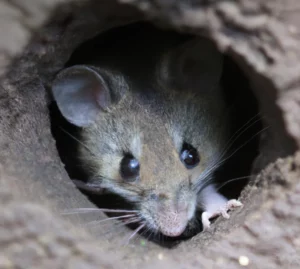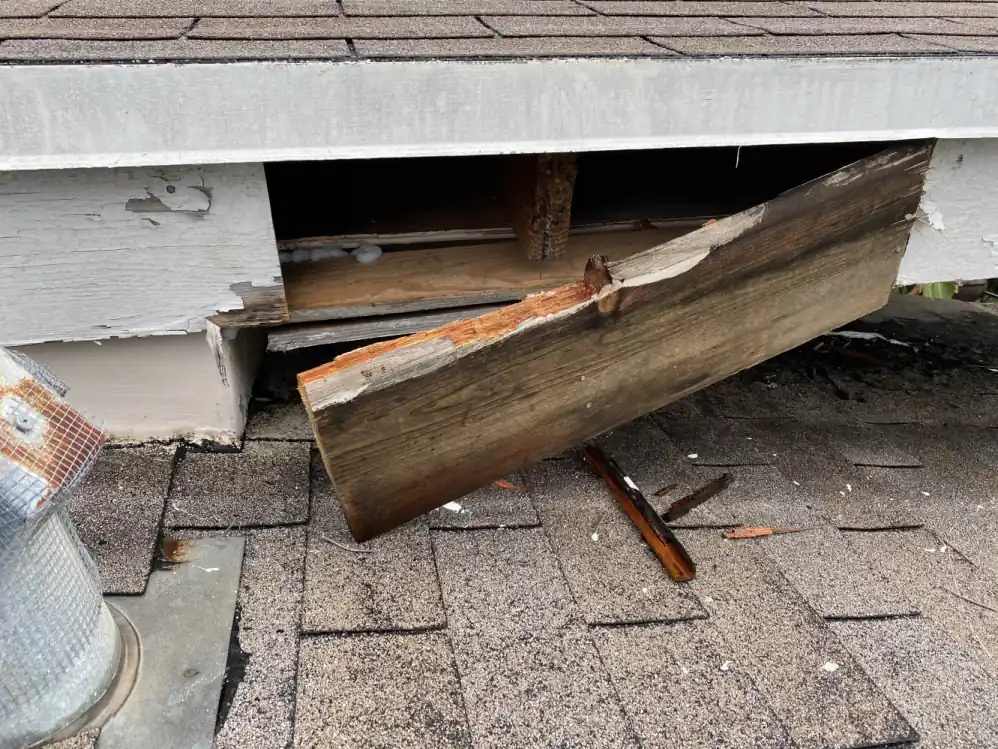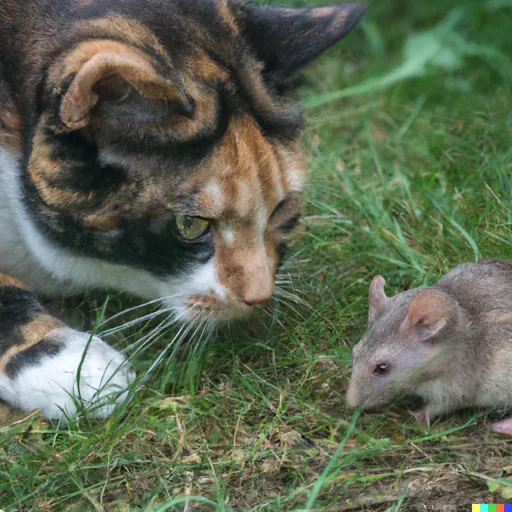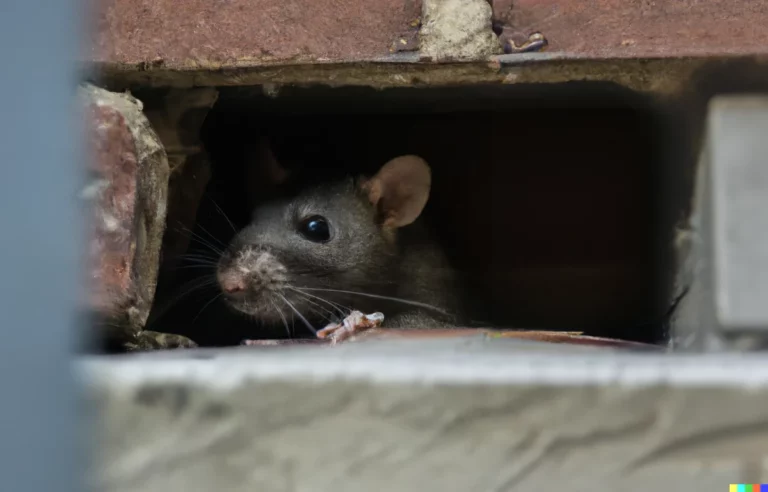Table of Contents
ToggleThe house mouse possesses small back legs and a tail equal in length to its combined head and body. The color of these creatures is usually dark grey. However, some have a light-brown back and a light-brown belly. Reaching full size, they normally tip the scales at 15 grams (0.5 oz) and extend 8 cm (3 inches) in length.
Female mice give birth to 5 to 10 groups of offspring each year. Each group consists of around 6-8 little ones. The typical house mouse has a lifespan of approximately 1 year.
How Do They Get Into A Home?
The house mouse typically enters homes in search of sustenance and refuge during autumn and winter. These mice can enter homes through small openings in doors, walls, and the home’s foundation and build nests. Impressively, they can fit through even the tiniest of spaces—just about 1 cm, which is smaller than a dime.

You may notice their are mice in your house when you see mouse droppings. They can be near food, under stoves, refrigerators, and sinks. Additionally, you could see holes in boxes and bags containing food or trash.
Where Do Mice Come From?
Mice can enter homes through tiny holes in walls, floors, and the bottom of the building. Many times, people don’t notice these tiny entry points until they see other proof of a mouse invasion. Because of their slim bodies, mice can squeeze through much smaller spaces than one might think.
Mice can get into houses through openings in windows or roofs, and even through sewer lines or pipes. If drain pipes aren’t sealed well, mice could come in through sinks or baths. They can also enter through gaps around pipes and gas lines for ovens.
Due to colder weather, infestations usually start in autumn. Once a group finds a cozy and secure place, they hardly go outside. Mice multiply fast, and their numbers can go beyond 200 in just a few months.
Prevent mice from entering your house by closing up any gaps, crevices, or holes with metal or concrete. Ensure doors and windows shut securely. Store food items in metal or glass containers with snug lids, and throw away food scraps quickly. Reach out to an expert at On Demand Pest Control for more help.

What attracts mice to your house?
Two primary factors that attracts mice to your home are food and shelter. If you don’t clean up well and leave food scraps on the floor or countertops, these rodents will surely enjoy it!
Rats and mice require a safe haven, especially in the winter season to escape the extreme cold. This is also essential when they search for a cozy area to nurture their offspring. A warm shelter with numerous hiding spots is ideal, and a cluttered space makes it even better.
Mice can fit through tiny gaps, even those smaller than 2cm across. Rats need just a bit more room. This means that any small hole leading to the outside can be an entry point for rodents into your house.
If you’re dealing with a mouse infestation and need advice on how to handle it, our blog post on Controlling Black Mice is a must-read. This post provides practical tips on identifying mouse species, spotting signs of infestation, and eliminating mice from your property. It also emphasizes the importance of professional pest control services in managing mouse issues effectively.
Does One Mouse Mean More?
If you spot a single mouse in your home, it could mean a rodent infestation. Chances are there are a lot more hidden nearby. This is more true during daytime or when the mouse is in open spaces, such as the middle of the room.
When a mouse community gets too big, some have to leave their nest at unusual hours. Small and weak mice face more challenges. They look for food in the daytime to avoid fighting for the best food.
How to Keep Mice Out of Your House
A simple step you can take is to clean and arrange your area well. This helps get rid of any leftover food like crumbs, sugar bits, or dry juice stains. Rodents are drawn to leftover food, so make sure to clean it up right away. Store all food, including pet food and particularly dry goods and compost materials, in airtight containers for added protection.
Next, check your home to ensure it’s well-sealed. Fix large gaps in the floors. Repair damaged air vents, holes in outside walls, and baseboards. Clean cabinets and remove items that can be used as nesting materials.
Mice and rats have an exceptional sense of smell, making powerful odors like peppermint oil uncomfortable for them. Put 8-10 drops of oil on cotton balls. Then place them in the corners of a room or near places where they might enter. Change the cotton balls every few days.
Additionally, you can use devices that produce a high-pitched sound unappealing to rodents.
If you love cats and want a furry friend in your home, now is the perfect chance you’ve been looking for!
Do Cats Keep Mice Out of Your House?
For sure, cats are good at keeping rodents away in areas they can reach. Mice don’t like the smell of cats, even if the cats don’t actually hunt them. Since mice hate the scent of cats, they will stay away from where they might be easily seen.
Cats can’t catch mice when they go back to your home’s walls. So, cats only keep mice away from your living areas. If you have a cat, don’t forget these tips. They will help make your house less attractive to mice.

How to Deal with a Serious Mouse Infestation
Even with your best efforts, a serious mouse infestation can sometimes be challenging to handle alone. When prevention and home remedies fall short, it’s crucial to turn to professionals who have the expertise and tools to effectively address the issue. On Demand Pest Control is ready to help ensure your home returns to a safe and mouse-free environment.
In conclusion, understanding how mice infiltrate homes, recognizing the signs of infestation, and taking preventive measures are vital steps towards a rodent-free household. Remember, it’s not just about getting rid of these pesky creatures, but also about maintaining a clean and secure home environment that’s unfavorable for them to thrive. Stay vigilant, and you’ll keep your home mouse-free!
If you’re interested in learning more about the fascinating anatomy of mice and how it allows them to infiltrate even the smallest spaces in your home, check out our blog post on “Do Mice Have Bones?”.
This post delves into the intricacies of a mouse’s skeletal system and dispels common misconceptions about their bone structure. It also provides practical tips on how to prevent these tiny creatures from entering your home.




